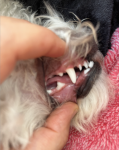Yikes! So, I just came back from a doggie dentist visit and they want to extract 4 lower teeth -- 2 incisors and his 2 lower canines -- this would be an invasive surgery since these teeth are mainly in his jaw. Our poodle lost all his baby teeth by 7 months, but these 4 teeth have been super slow to come in. By now, I honestly thought he would not be getting his canines. However, they're now barely showing the tips, but they are under his tongue! His 3rd set of incisors are coming in twisted, apparently.
I've read a lot about base narrow canines and how common it is in poodles, but have not heard/read of anyone dealing with this scenario. The good news is he is happy, playing, eating and seems totally fine. We are getting a 2nd opinion, but curious if anyone has experienced anything like this:
We don't want him in pain later in life, but I'm very curious to hear about people's experiences... if you have ever seen this before.
Many thanks, in advance.
I've read a lot about base narrow canines and how common it is in poodles, but have not heard/read of anyone dealing with this scenario. The good news is he is happy, playing, eating and seems totally fine. We are getting a 2nd opinion, but curious if anyone has experienced anything like this:
- no retained puppy teeth
- lower canines poking through under tongue
- 14 months old
We don't want him in pain later in life, but I'm very curious to hear about people's experiences... if you have ever seen this before.
Many thanks, in advance.







